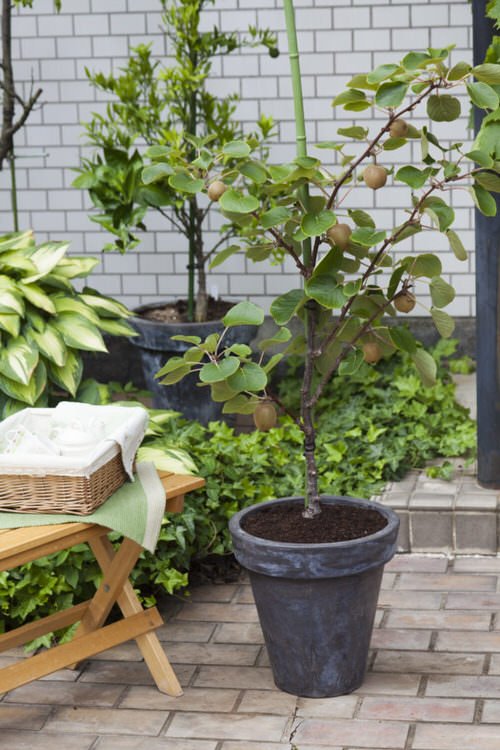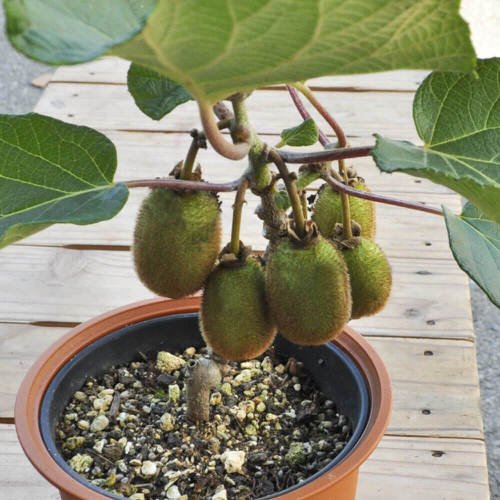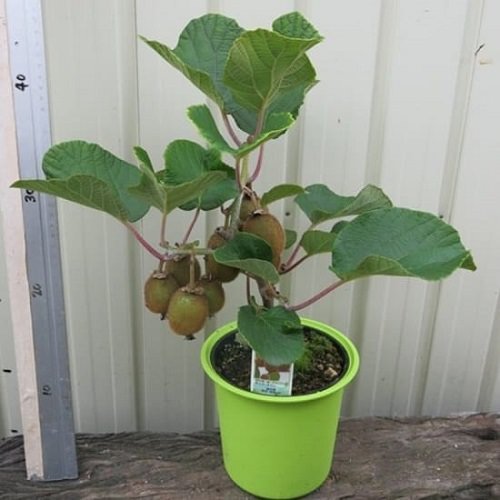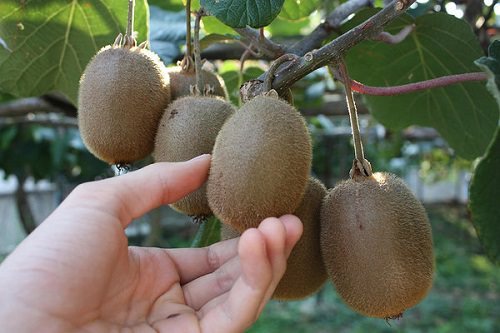The best way to enjoy refreshing kiwis is to grow them on your own! Here is all the information on How To Grow Kiwi In a Pot!
Whenever we hear the word kiwis, an image of delicious aromatic fruits comes to our mind. But is it possible to grow this in a home garden? In a limited space, especially in containers? Well, the answer is yes! Here is all you need to know about How To Grow Kiwi In a Pot and enjoy it homegrown!
Check out our article on growing Oranges in pots here
What are Hardy Kiwis?
Hardy kiwis are smaller than their cousin kiwi, which are generally available in store. Also, hardy kiwis are dioecious, which means if you want the plant to bear fruits, you should plant at least one male plant for every 8-10 female plants.
However, if you want to grow just one plant, then go for self-fertile varieties like ‘Jenny’ and ‘Issai.’
USDA Zones: 7-10
Choosing the Right Variety
- If you are a beginner at planting Kiwi, Ananasnayais a good variety you can choose. This vigorous growing productive vine bears grape-sized, aromatic fruits.
- For the early production of kiwifruit, go for Geneva. Another highly productive variety is Dumbarton Oaks.
- To grow aromatic fruits of larger size, plant Michigan State variety. It can tolerate cold down to USDA Zone 5.
- The kiwifruit of Ken’s Red is not only delicious, but it also looks attractive with red-color skin.
- Don’t want to go through the trouble of buying both male and female variety? Issai does not require a male pollinator, as it is a self-fertile variety.
How To Propagate Kiwi?
You can propagate this plant from seeds or cutting both. It is up to you. It takes around 3 to 5 years for a kiwi plant to produce fruits grown up this way. So you have to be patient!
Get seeds from the nearest nursery or any online store. It is preferable to plant kiwi from cuttings as better cultivars can be planted that way. No matter which way you choose for planting, both male and female plants should be planted if you want your vines to bear fruits.
Pro Tip: Get a potted plant from a nursery as it will save the time the plant takes to grow from seeds or cuttings. Also, it would be a good idea to get a self-pollinating variety.
Choosing a Container
Begin planting in a 12-14 inches container with ample drainage holes. After a couple of years, or when you feel that the vine has outgrown the current container, transplant it to a bigger pot according to the growth. While transplanting, make sure you don’t break the root ball.
Support
Kiwis require sturdy support as the vines can grow around 25-30 feet in length and become quite heavy. You can train them to climb over a patio overboard or install a strong trellis structure for proper support. You can also grow these plants on a big balcony or rooftop.
Requirements for Growing Kiwis in Pots
Soil
Kiwi does great in well-draining, loamy to lightly heavy soil. If it’s rich in organic matter like leaf mold, compost, or aged manure, it’ll further aid in the plant’s growth. The pH level can be between slightly acidic to slightly alkaline.
Clay-rich soil is detrimental and must be avoided. Also, do not use too sandy soils.
Location
This vine needs full sun for healthy and vigorous growth. So place it at a spot where it receives maximum sunlight. An exposure of 5 to 6 hours of sunlight would be best.
Temperature
Cold climate varieties will do well in the temperature range of 40º-60º F (4.44º-15.56º C). For warmer regions, kiwi will be best from 56º-77º F (13.33º-25º C). If the plant is young and not established, it may be adversely affected or killed at a temperature below 14º F (-10º C)
Watering
Keeping the soil moist is crucial for the proper growth of the plant. Do not overwater as kiwis do not like to sit in standing water and it can also cause root rot. Water thoroughly, but avoid saturating too frequently.
Fertilizing
Kiwis will grow actively once established and requires regular fertilization. But the roots are sensitive and can burn off if you overuse fertilizers.
Using a time-based balanced granular fertilizer like 16-16-16 as per the instructions on the label, 2-3 times a year will be more than enough. Alternatively, you can also use soybean meal.
Kiwi Plant Care
Pruning
It is necessary that you prune kiwi vines at least once a year. The best time for pruning a female plant is in the winter, as this is when this plant is dormant. Immediately after flowering, you can prune male plants. For self-pollinating ones, do it in winter. Again, you’ll also need to do a wee bit of pruning in summers.
Use a pair of sharp pruners for performing this task. Snip away any dead or decaying branches. Also, any lateral growing vine which is not supported by the trellis should also be pruned.
Mulching
As this plant does well in moist soil, you can add a layer of mulch so that the soil does not become dry. Use a mix of compost or shredded leaves for mulching.
Do not apply mulch around the base of the vine. Keep it 2-3 inches away from the base.
Pests and Diseases
One remarkable thing about kiwi is that it rarely attracts any pests or diseases. You might find a few four-legged insects lurking, which you can quickly get rid of by spraying the vine with an organic neem oil solution.
If you own pets, especially cats, protect the vine, as an overzealous cat can be the death of a new plant.
Overwintering Kiwi
Although kiwis can manage temperatures down to -15 F (-26 C), it’d be a good idea to keep them safe from winters for good quality fruits, especially when the plants are young. Bring them indoors and wrap the stems using a cloth or a piece of blanket. Also, make sure it gets some sunlight exposure during the day.
After 3-4 years of overwintering, the plant will be strong enough to take care of its own.
Harvesting and Storage
If you start your kiwis from seeds, it is likely that your plants will begin producing fruits in around three years. There are a few varieties that bear fruits much earlier such as the Arctic, which can bear fruits after just one or two seasons.
Once the vine starts bearing fruit, it can produce around 40-50 pounds of fruit annually. You will be amazed to learn that Kiwis can produce fruits for up to 45-50 years!
Fruits are ready for harvest when they start to soften. Taste the fruit to check if it is ripe. You can store the fruits for around five weeks in a refrigerator.









Is it possible to have female and male plant in a single kiwi fruit?
Very nice plant kiwi I am also interested in cultivate kiwi but here is temperature is 10 to 48 centigrade is it possible please help me .now at this time temperature is 45 centigrade.
Just want to know if one kiwi fruit contains male and female seedS
Kiwi Jenny is self fertile and hardy kiwi, Issai is also self fertile.
Yes Kiwi contains both sexes of seeds, it must do as the male flowers and plants cannot produce fruit, therore all Kiwi plants male and female come from the seeds of fruit from a female kiwi.